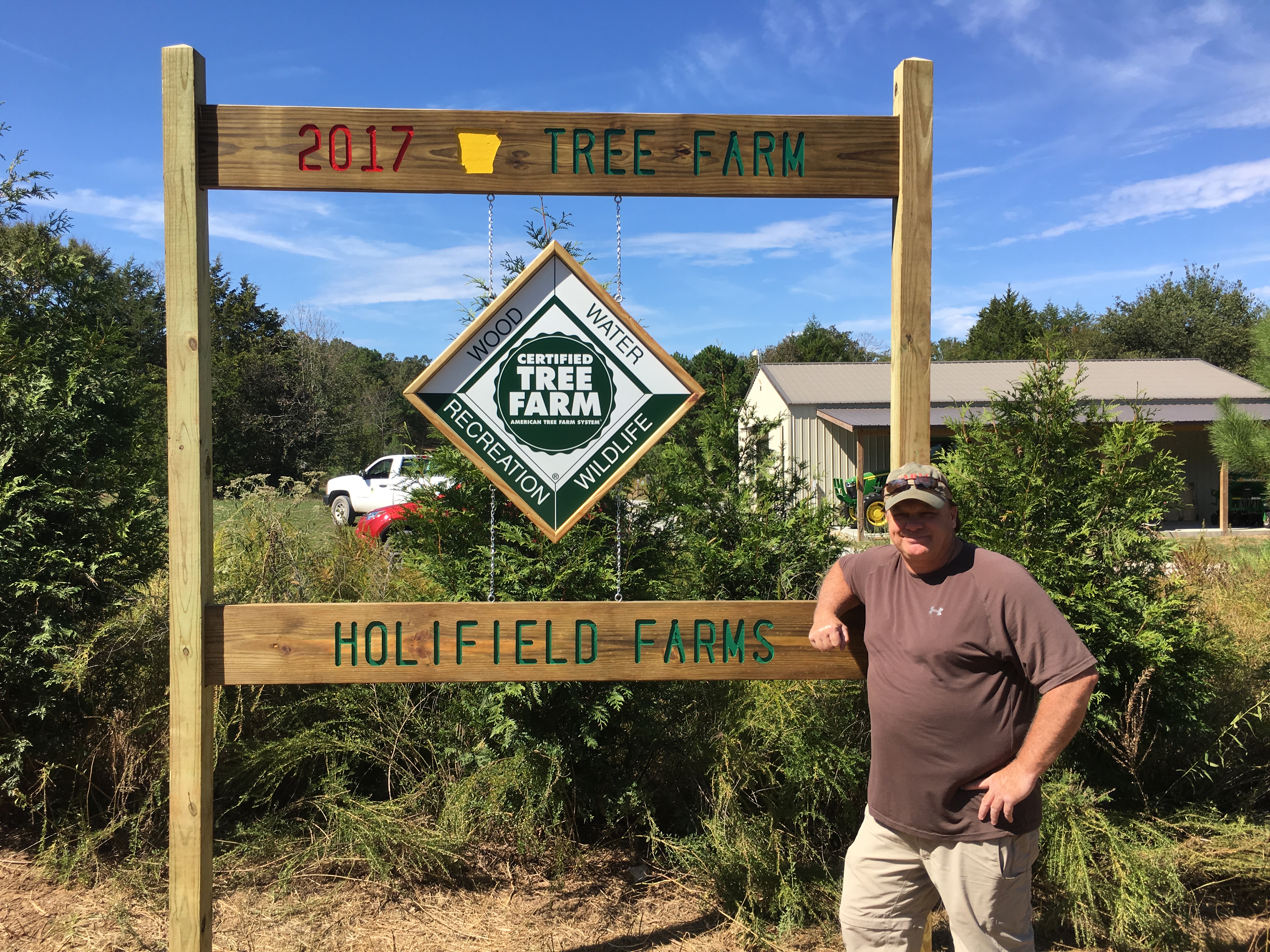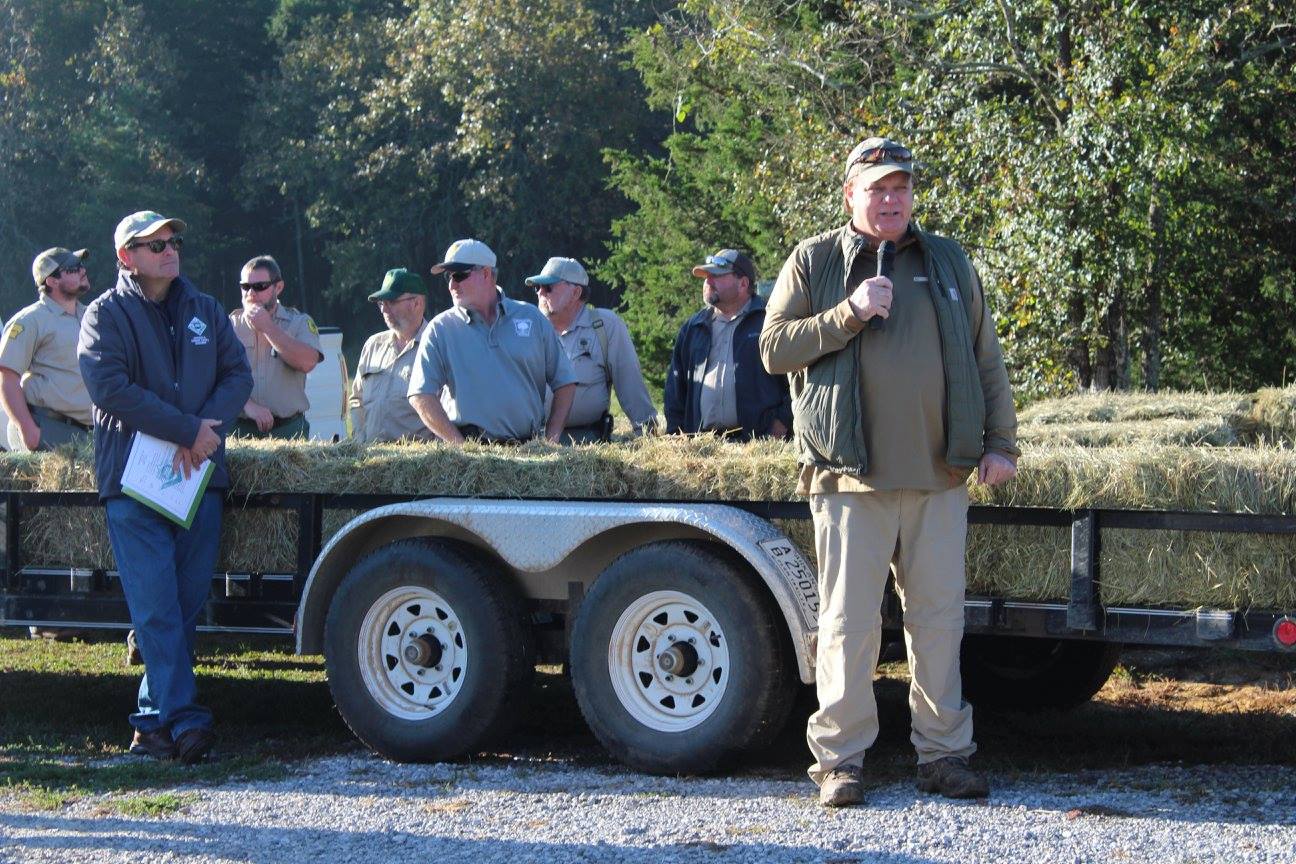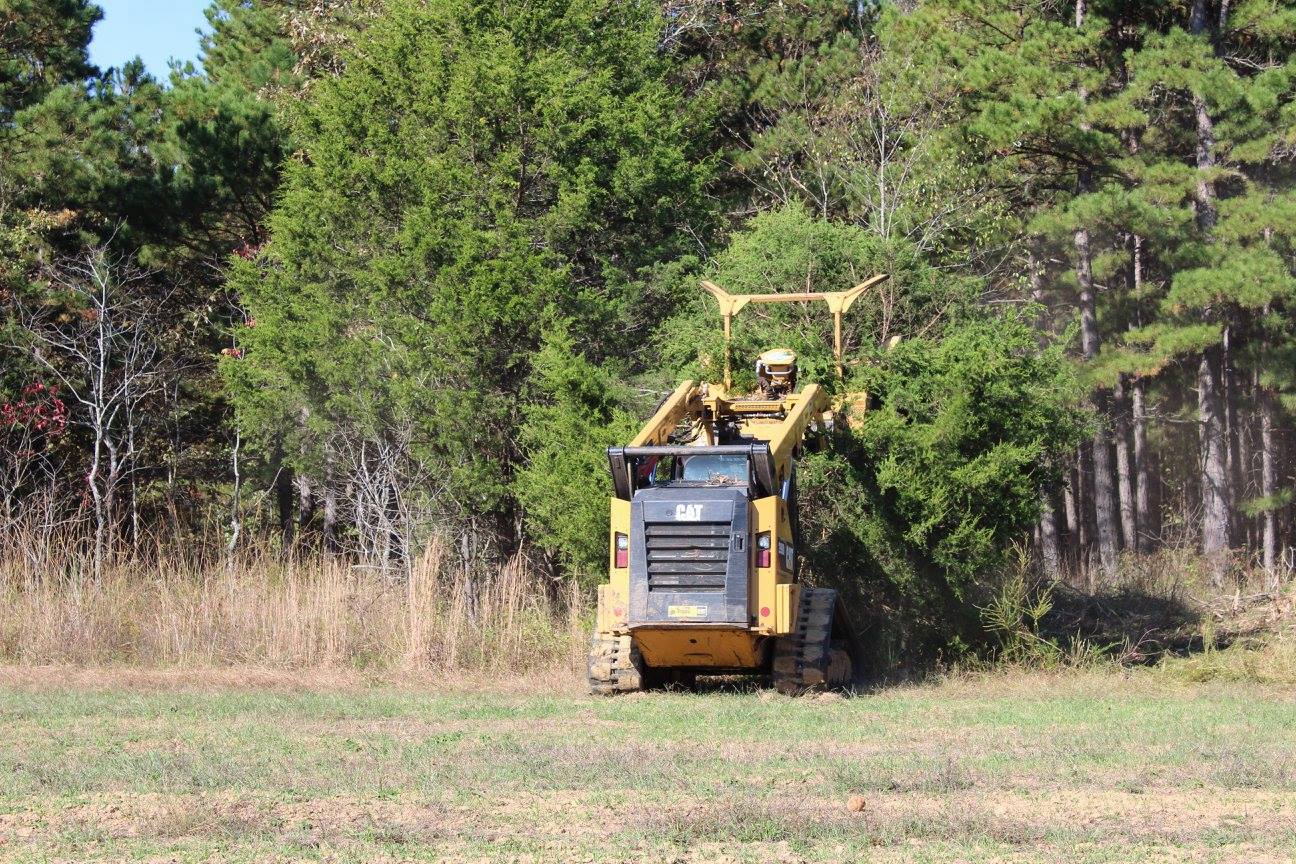South Nominee: Paul Holifield from Arkansas
What makes them outstanding?
The Holifield Family was
nominated by Tabitha Holloway of the Arkansas Forestry Commission who is a
certified Tree Farm inspector in District 8 and supported by Wade Hargrave of
Hargrave Forest Management who is the District 8 Chair.
is a
certified Tree Farm inspector in District 8 and supported by Wade Hargrave of
Hargrave Forest Management who is the District 8 Chair.
In his nomination, Tabitha said “Mr. Holifield is an active landowner that encourages and extends help to other landowners, and neighbors, while striving to stay up to date on current, or the best, forest and wildlife management activities for his property. He has used sound forestry management practices, including following plans for timber thinning, prescribed burning, and Arkansas Voluntary Best Management Practices, and strives to follow his goals for both the short and long term.”
Paul is a member of Ducks Unlimited and has served on several committees and was even a past Chair. He is a member of the Quail and Grassland landowner group in Batesville and was a part of the National Wild Turkey Federation. He has a long history and background in advocating for wildlife in the state, and that passion is showcased in the management of his property, as well as his commitment to working with other landowners to develop their interest in maintaining or developing habitat for quail restoration and management.
Mr. Holifield’s dedication toward maintaining the strict standards of sustainability make him the perfect representative of the American Tree Farm System and quite deserving of this award.
Tree Farmer story
It was decades ago in a different time and place, when brothers were heading north to find better paying jobs in the cities. My father stayed home to help work the family farm, having several jobs in his lifetime, even owning a tree nursery once. He loved to plant trees and shrubs. Whatever he did, he worked hard, and always remained close to the land.
I know I inherited his love for the land, willingness to work hard to improve it, and great appreciation for the flora and fauna that live there. Some of my favorite memories are of helping my dad plant fruit trees and shrubs. That same year we went out to Christmas tree farm unto what was by then known as The Old Place to cut a Christmas tree. It did not turn out to be the most beautiful tree, but nevertheless the one I will always remember the most.
I would go on to finish pharmacy school, buy the first of several pharmacies, and spend most of my spare time on my wife’s family farm. In 1998 we would have the opportunity to buy 80 acres adjoining my wife’s parents’ property. In a series of seven more purchases, our farm would grow to 660 acres by 2016. It would include beautiful open timber, cedar glades, old fields cleared of cedars and planted with improved loblolly pines, and fields once planted in cotton and sorghum that would become food plots for wildlife. We planted others fields in native warm season grasses and wildflowers for pollinators.
I wish I was expecting a big monetary windfall in the future to justify all of my endeavors on the tree farm. It would also be wonderful to retire from my businesses and devote full time my thoughts and energies to doing something I dearly love and enjoy, planting trees, timber stand improvement, prescribed burns, and all the other practices we call forest stewardship. I
 I'm not saying I don’t enjoy
pharmacy. I am extremely blessed to do
what I do and I would miss my patients tremendously. But if I had the option, I would be there on
the farm. Truth be told, I have the
luxury to be there several days a week.
It can be strenuous, and sometimes frustrating, but always satisfying.
I'm not saying I don’t enjoy
pharmacy. I am extremely blessed to do
what I do and I would miss my patients tremendously. But if I had the option, I would be there on
the farm. Truth be told, I have the
luxury to be there several days a week.
It can be strenuous, and sometimes frustrating, but always satisfying.
I have always thought the farm had potential to be utilized and hold more wildlife. I love to hunt deer with a bow, and turkey hunting may be everyone’s favorite. We have plenty of deer, but turkeys could be more plentiful. And I believe the forest stand improvement with its more open canopy has greatly improved our wildlife population. Turkeys can move more freely through the timber and are seen more frequently. Deer are thriving on the forbs from the sunlight reaching the forest floor. In some places, it is like whole new food plot that didn’t require planting. I look forward to the spring and those familiar sounds of the eastern wild turkey.
Creating wildlife habitat is paramount, but one would be remiss if enough attention was not given to breeding and brooding habitat. It is becoming extremely evident that by eliminating non-native grasses and restoring habitat like pine savannah and prairie native warm season grasses that the bobwhite quail can regain a foothold. Their mating calls and subsequent sightings were reward enough for the many hours spraying, planting, and maintaining the landscape.
The wildlife alone would justify the work, but sometimes you are compelled to just practice the best forest management that you can. Duck hunters have already paid for what we have done to our bottomland forests and many don’t even know it. Too long our forests have been either high graded or left alone to their own devices. Planting trees, whether it be hardwoods or improved loblolly pines, and FSI is a great step in the right direction. One thing we know, the health of our forests will someday dictate our own wellness.
It is much easier to accomplish tasks, feel more comfortable, and see results if you get good advice. Private landowner and friend Mike Cushman has helped me tremendously in having an example of good forestry practices. Wade Hargrave introduced me to prescribed burns and many of the particulars to have a successful and safe fire. I rely on the Arkansas Forestry Commission and particularly Tabitha Holloway with their expertise in all tree matters. It’s easy to appreciate folks like Becky Long and the NRCS for their hard work and recommending programs with cost shares to help pay for the many improvements that can be done. It is hard to justify the cost of seeds for pollinators without their help. But what a wonderful feeling to see the beauty of wildflowers and to know at the same time we are greatly helping our pollinators. Tree farming can be hard work at times, and it helps to have folks like Jennifer Johnson and the Arkansas Forestry Association providing educational opportunities, giving advice, and encouraging best management practices. They are truly advocates to private landowners like myself and the voice of the timber industry. There are many motivators to be a good steward of the land. The Bible tells us that if a tree does not produce good fruit, it is cut down and thrown in the fire. Reminds me that our Savior likes good stewards.
For the following areas describe how the landowner's management addresses it
Wood: Dr. Holifield manages his forests for the typical timber management, but for management options that benefit wildlife. He consults forestry professionals with all he does, contacting the County Forester with the Arkansas Forestry Commission or his consultant forester for opinions, forestry plans, and advice. Dr. Holifield has 506 certified acres, with 328 wooded acres, including 14.3 acres of planted loblolly pine.
The
main objective for the property is to provide much needed wildlife habitat for
declining species such as eastern wild turkey and bobwhite quail. A majority of the property is hardwood or a
mix of hardwood and long established shortleaf pine (282.7 acres). The timber markets, low soil fertility, and
site indices in the area make it difficult to manage the timber for commercial
value. As such, the hardwood is managed
to provide for wildlife habitat with a varying age structure and density. Prescribed burns as used to increase
available sunlight to herbaceous plants used for food and cover, and to
increase the quality and quantity of grasses and forbs. Forest stand improvement practices have been
used on a majority of the hardwood, roughly 102 acres completed so far, with an
additional 60.3 acres planned. Some of
the planted loblolly pine will undergo a pre-commercial thinning this year to
reduce competition and to improve overall health and growth. Pine will continue to be evaluated for insect
and disease control, and a possible harvest later on.
the hardwood is managed
to provide for wildlife habitat with a varying age structure and density. Prescribed burns as used to increase
available sunlight to herbaceous plants used for food and cover, and to
increase the quality and quantity of grasses and forbs. Forest stand improvement practices have been
used on a majority of the hardwood, roughly 102 acres completed so far, with an
additional 60.3 acres planned. Some of
the planted loblolly pine will undergo a pre-commercial thinning this year to
reduce competition and to improve overall health and growth. Pine will continue to be evaluated for insect
and disease control, and a possible harvest later on.
Water: Dr. Holifield has several ponds on the property, 15 ponds totaling 5 acres (cattle excluded from all), and several streams, including a portion of Fool Creek and 2 additional perennial streams (no names, totals 7,745 feet). The creeks and streams have an established streamside management zone to prevent erosion issues, includes 3.7 acres in streamside management zones for best management practices. Before any practices are conducted, all Arkansas Best Management Practices are followed where applicable. This includes the streamside management zone on streams, creeks and ponds, and erosion controls on firebreaks including water bars and wing ditches where needed. Loblolly pine was planted as a buffer along one of the perennial streams and a portion of Fool Creek but also acts a streamside management zone to reduce sediment runoff. An additional 100 pine were planted this last spring (2017) to add to the buffer/SMZ.
Wildlife including threatened and endangered species: Wildlife is a main focus for Dr. Holifield, as he strives to provide the best habitat for wildlife species such as white-tail deer, eastern wild turkey, and bobwhite quail. Dr. Holifield and several of his colleagues hunt the property, with a strict rule of only using bows to hunt white-tail deer. There are roughly 32 wildlife food plots, several are permanent openings that have been planted in native warm season grasses or wildflowers (pollinator mix), or clover (to reduce erosion). Combined it totals 31.4 acres of food plots or wildlife openings. Other food plots have been planted with clover, corn, wheat, oats, soybeans, chufa and turnips. Additional wildflowers of 1.1 acre will be planted this year to provide food year-round for his 2 honeybee hives, adds to the 0.5 acre already planted in wildflowers. Native warm season grasses have been planted on almost 10 acres in 3 different locations. Additional native warm season grasses will be planted later to add to that already established. Though none are present, monitoring for threatened and endangered species is continued. Several species are present in the county that could possibly be found on the property that have not been found yet including several salamanders, bald eagle, and several bats, as well as a long list of vascular plants.
Recreation and Aesthetics including special sites: The property is mainly used for recreation, mostly hunting, but Dr. Holifield also has a small target lane set up for shooting. The property has been used for several special occasions including his daughter’s college sorority fall outdoor outing, with 150 in attendance.
Roads and trails are maintained throughout the property for access. In all practices and activities on the farm, Dr. Holifield is a strict advocate of aesthetics. Forest stand improvement practices are used to reduce visual impact, including taking chainsaws to cut up leftover tops or logs, as well as to prune necessary branches out of the trails or those that have broken in a storm. Firebreaks are maintained with a rock-rake on the back of a tractor, which reduces erosion and only removes leaves/sticks from firebreak with very little top soil removed.
A few areas could be considered a glade or barren, as shallow soil and exposed rocks are characteristic of a glade. Cedars have encroached within these areas creating a very dense woody layer. Several options have been planned for cedar removal in these areas, but are not planned within the next couple years.


